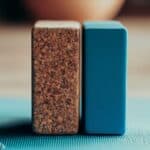A Guide to Choosing the Perfect Shape Yoga Block for Your Practice
When it comes to yoga, props can be your best friend. One such prop is the yoga block.
This article focuses on the choice of yoga block shape. For those of you looking for the more comprehensive guide to choosing yoga blocks, I suggest this article Block by Block: A Comprehensive Guide to Choosing the Perfect Yoga Block.
- Yoga blocks are a useful prop in yoga practice as they provide stability, support, and extension where needed.
- Different block shapes, such as rectangular, cork, wedge, curved, and foam blocks, cater to different needs and preferences.
- Rectangular blocks are versatile and can be used at different heights, while cork blocks are eco-friendly and provide durability. Wedge blocks offer extra height and support, while curved blocks contour to the body’s natural curves and are ideal for restorative poses. Foam blocks are lightweight and suitable for beginners or those with limited mobility.
The Importance of Yoga Blocks in Your Practice
You may have seen them in your yoga studio or gym and wondered why people use them or if they are necessary. In short, they can enhance your practice and make certain poses more accessible.
Yoga blocks are typically made of foam, cork or wood and come in various shapes and sizes. They are used to provide stability, support and extension where needed.
In some cases, blocks can help you access the full expression of a pose that would otherwise be difficult without assistance. The benefits of using blocks are numerous: they help in maintaining proper alignment, prevent injury by reducing strain on joints or muscles, and allow for longer holds in certain poses to deepen the stretch.
Different Block Shapes for Different Needs
Not all yoga blocks are created equal! Depending on your body type, level of flexibility or specific pose needs, different block shapes may serve you better than others.
Rectangular blocks are probably the most common shape you’ll find at a studio or gym but there is a wide range of options available in terms of shape. Wedge-shaped blocks have angled sides which make them ideal for modifying poses that require extra height or support while also providing an easy grip surface for hand placement.
Cork blocks not only provide good grip but also offer sturdiness – perfect for more advanced poses that require greater support from your props! Meanwhile curved blocks contour to your body’s natural curves making them ideal for restorative poses that allow you to relax into gentle stretches without putting added pressure on joints like hips.Most importantly when deciding which block is right for you it depends on what kind of practice you have so choose one that supports YOUR needs!
Rectangular Blocks
If you’ve ever taken a yoga class, chances are you’ve used a rectangular block at some point. These blocks are the most common shape of yoga blocks and are often found in studio classes, as well as in many home practice toolkits. The rectangular shape is highly versatile and can be used for a variety of poses, including standing, seated, and balancing poses.
One of the great benefits of using rectangular blocks is their ability to be used at three different heights depending on orientation. For example, if placed horizontally with the longer end facing forward, you have the highest height.
Turned on its side with one longer end resting on the ground and one shorter end facing up gives you a medium height option. And finally, turned vertically with the shorter end facing forward gives you the lowest height option.
This versatility allows for customization in your practice to best suit your needs. Whether you’re using it for support in a standing pose or extra cushioning in seated postures, rectangular blocks have got your back (and hips).
Cork Blocks
When it comes to yoga blocks, cork is a popular material choice among many yogis. Not only is it eco-friendly, but it’s also incredibly durable and sturdy. This makes it ideal for advanced poses that require a lot of support and stability.
In addition to its durability, cork blocks also provide a natural grip that prevents slipping. This is especially helpful when practicing in hot or sweaty conditions where hands and feet are prone to slipping on traditional foam blocks.
The natural texture of the cork material allows for a better grip, which can help you feel more secure in your practice. One thing to keep in mind when using cork blocks is that they tend to be heavier than their foam counterparts.
This can make them feel a bit cumbersome when carrying them to and from class. However, the tradeoff is worth it if you’re looking for a block that will last you through years of advanced practice.
The Eco-Friendly Choice
If you’re someone who cares about reducing your carbon footprint, then cork blocks are the perfect choice for you! Unlike foam blocks which are made from synthetic materials, cork blocks are made from the bark of the cork oak tree.
Harvesting this bark doesn’t harm the tree, making it an eco-friendly and sustainable option. Not only are they eco-friendly, but they’re also naturally antimicrobial and hypoallergenic.
This means that they won’t harbor bacteria or allergens like traditional foam blocks can over time. If cleanliness is important to you (and let’s be real – it should be!), then investing in a set of cork blocks might just be worth considering.
Wedge Blocks
Triangle Magic
Wedge blocks are a unique shape that adds versatility to your yoga practice. They’re triangular with varying angles, making them ideal for modifying poses that require extra height or support.
Wedge blocks come in different sizes, so you can choose one that fits your body and practice level. If you’re a beginner, start with a small block and work your way up.
One of the most significant benefits of wedge blocks is their ability to stretch and strengthen specific muscle groups. For example, if you want to stretch your hamstrings during forward folds or seated poses, place the wedge block under your pelvis to tilt it forward slightly.
This adjustment will help lengthen the hamstrings while keeping your spine long and straight. On the other hand, if you’re working on strengthening your core muscles during plank or boat pose, place the wedge block under your feet instead of hands or forearms to make the pose more challenging.
The Ideal Support
Another advantage of using wedge blocks is that they provide comfortable support for various parts of the body during different postures like downward-facing dog or supported bridge pose. The angle created by placing these blocks under certain areas gives an added support without any strain on joints; hence there’s less chance for injury when practicing advanced postures.
Overall, Wedge block is an ideal addition to any yoga practice as it adds a new dimension of versatility by modifying different poses for better alignment and support. So next time when working out with asanas keep in mind how wedge block can help achieve specific goals while improving flexibility and strength!
Curved Blocks
Contouring to the Natural Curves of Your Body
As its name suggests, the curved block has a unique shape that is designed to contour to the natural curves of your body. Unlike regular rectangular or wedge blocks, it provides targeted support for areas like the spine, hips, and shoulders.
This makes it ideal for restorative poses that require gentle support without putting too much pressure on your joints. One of the main benefits of using a curved block is that it can help improve spinal alignment.
When placed under your back or neck during poses like bridge or fish pose, it helps to open up your chest and release tension in your upper back. This can lead to better posture over time and may even alleviate chronic pain caused by poor alignment.
Gentle Support for Restorative Poses
Curved blocks are also great for restorative yoga practices that prioritize relaxation and rejuvenation. When used in poses like child’s pose or pigeon pose, they provide just enough support to let you fully relax while still getting all the benefits of each pose.
They can also be used during meditation practices as a way to elevate your sit bones and reduce discomfort in your lower back. Overall, if you’re looking for a block that can provide gentle yet effective support for restorative yoga poses and improve spinal alignment during more active poses, then a curved block might be just what you need.
Foam Blocks A Lightweight Option for Beginners or Those with Limited Mobility
Foam blocks are a popular choice for those who are new to yoga or have limited mobility. These blocks are incredibly lightweight and easy to handle, making them perfect for beginners who may not be used to using props during their practice. The soft texture of foam blocks provides a gentle support that can be very comforting during restorative poses or meditation practices.
Additionally, foam blocks come in a variety of colors, allowing you to add a touch of personality to your practice. For beginners, foam blocks can help reduce the risk of injury by providing extra support and stability during poses that require balance or flexibility.
Foam blocks can also be used as an aid in learning proper alignment and form which can help with posture and overall body mechanics. Moreover, foam blocks are an affordable option for those just starting out in yoga and unsure if they want to invest in more advanced yoga props. The Soft Texture Provides Comfortable Support During Restorative Poses or Meditation Practices
Restorative yoga is all about finding comfort and relaxation in your poses. Foam blocks offer the perfect amount of support while still being comfortable enough to aid in relaxation.
They provide stability and cushioning, allowing you to hold poses longer without discomfort. During meditation practices, foam blocks can also provide extra height or padding underneath your hips or knees which helps alleviate any pressure on those areas so you can sit comfortably for longer periods of time. Available in Various Colors to Add Personality
Foam Blocks come in a variety of colors which gives you the freedom to choose one that matches your personality or style preference. You can use different colors depending on what mood you’re trying to evoke during your practice – vibrant colors like reds and yellows might energize while muted colors like blues might promote calmness.
Having colorful props can be a great motivator to continue your yoga practice because it adds an element of fun and creativity. It also allows you to differentiate your blocks from others in class or at the studio.
Conclusion
Yoga blocks are an essential tool for all yogis, no matter their level of practice. The right block shape can help you achieve better alignment, prevent injury, and deepen your stretches. Now that we have explored the various block shapes, it’s time to find out which one will work best for you.
If you’re looking for a versatile yoga block that can be used in different poses, the rectangular block is a great option. It’s available in different materials like cork or foam and can be used at three different heights depending on orientation.
On the other hand, if you’re after something eco-friendly and durable for advanced poses, then cork blocks are your perfect option. Wedge blocks are ideal for modifying poses that require extra height or support.
They come in a triangular shape with varying angles for support and can also be used to stretch and strengthen specific muscle groups. Curved blocks offer gentle support without putting pressure on the joints and are designed to contour the body’s natural curves – making them ideal for restorative practices.
Foam blocks are lightweight and easy to handle – perfect if you’re a beginner or have limited mobility. They have a soft texture that offers comfortable support during restorative poses or meditation practices and come in various colors to add personality to your practice.
Keep in mind that choosing the right yoga block is based on individual needs and preferences. Whether it’s versatility with rectangular blocks or eco-friendliness with cork ones – finding what works best for your practice is key!
More reading?
This article is part of a series of articles on the topic of choosing the perfect yoga block. Other articles in this series include:



